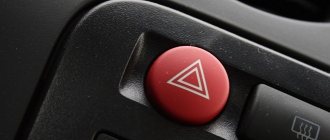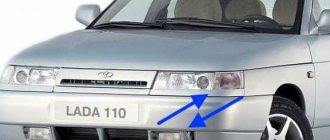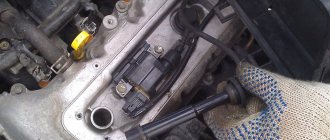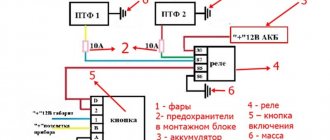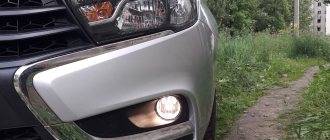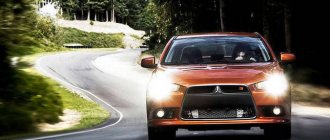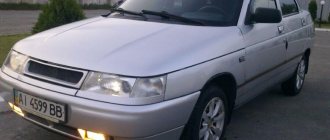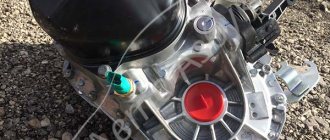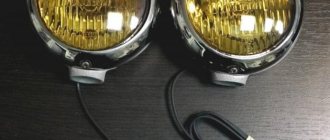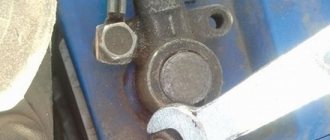In harsh Russian weather conditions, when the roads are not cleaned and there are not markings everywhere, an additional source of lighting is often required on the car. It is known that LED or xenon lamps not provided by the manufacturer are prohibited by law.
But what happens if you install auxiliary headlights on the roof, hood, radiator grille or bumper of a car? Is it possible today to additionally equip a car in a similar way, and what punishment might there be for this? Let's look at these questions in detail.
- Law
- Responsibility
Fog lights and lights
This type of light source is part of the overall vehicle lighting system. Lighting equipment is designed for more intense illumination of the road at night, as well as in bad weather, when the visible distance is insufficient for safe movement. This system includes:
- Headlights, taillights and brake lights.
- Car showroom lighting, glove compartment lighting, luggage compartment lighting.
- Front fog lights and rear fog lights.
- Illumination of registration plates and information control panel instruments.
Why turn on headlights during the day?
Having understood the purpose of fog lights and daytime running lights, let's talk about why there is a need to turn on any lighting devices during daylight hours. The increase in the power of power plants of production cars, together with the improvement in the quality of roads, leads to higher driving speeds every year. It is known that as speed increases, the driver’s eye begins to notice fewer and fewer details. Among constantly flashing buildings, glare from puddles, street lights, it is difficult to notice an oncoming car at high speed. This is especially true for cars with dark body paint, which simply blend into the asphalt, which leads to emergency situations.
A car with its headlights on is more visible during the day
In this regard, it was decided to oblige drivers to illuminate their cars even during the day. Thus, turning on headlights during daylight hours is not a whim of the State Traffic Inspectorate employees, but a necessity dictated by modern realities.
Types of foglights
According to traffic regulations, the use of fog lights is officially permitted; many manufacturers equip factory-produced cars with fog lights. But many universal types are also produced by third-party companies. By type there are:
- Front fog lights;
- Rear fog lights.
The design features differ in the source of light used. Common types of fog lights:
- Halogen. Relatively inexpensive light sources, in demand among car enthusiasts. The disadvantages include the short service life of the lamps. During intensive use, they require frequent replacement;
- Xenon. The characteristics of the light spectrum are better than those of halogen lamps. They work long enough. The price is quite high;
- LED fog lights. The highest price category. Lamps with excellent light beam. They have a long service life. Lamps are prone to overheating. Requires fairly good ventilation.
How to determine the visibility limit?
The use of fog lights is strictly regulated by traffic regulations. Poor visibility of the roadway is when the visibility to the car in front is less than 300 meters at dusk, as well as in a situation where it is raining, foggy or snowing heavily. How can you tell by eye in bad weather that visibility is limited? It is necessary to count the power line supports that are installed along the road. If less than 6 pieces are visible, then the view is difficult and is less than 300 meters. The distance between the pillars is fifty meters. In such conditions, it is necessary to reduce the speed of the vehicle and be extremely careful.
When are fog lights used?
According to standard No. 19.4 of the Traffic Regulations, front fog lights are designed for additional illumination of the roadway at night or when dusk falls, together with headlight devices. Use is permitted in unlit areas or in conditions of limited visibility caused by weather conditions. And also as running lights, instead of low beam, according to paragraph No. 19.5, during the day. A detailed explanation of traffic rules and GOST can be read in this article: https://businessman.ru/new-dnevnoj-xodovoj-ogon-razyasnenie-gost-i-pdd.html.
Separate regulations apply to the operation of rear lights. When according to traffic regulations do you turn on the fog lights installed at the rear of the car? Rear fog lights are intended only for additional identification of the vehicle in conditions of poor visibility: fog, snowfall, heavy rain, etc. Turning on in normal situations is prohibited.
What is written in the traffic regulations about light lights
Low beam devices or LED lights make the car more visible on the road. And, according to traffic rules, side lights are turned on only at night, since their power is too low, so the traffic rules limit the use of these lighting devices; they are not interchangeable.
However, not all cars are equipped with daytime running lights, or they may malfunction. What to do in this case? To get out of this situation, many drivers use fog lights during the day.
Whether this is justified can hardly be said unequivocally, especially since traffic cops often use this as a loophole to fine the driver for not having the DRLs on on the highway. Is this legal?
Installation
It is worth paying attention to the correct installation of additional lighting sources. Installation of fog lights according to traffic regulations in Russia has some features and limitations:
- The emitted light should be in the milky white spectrum or have a bright yellow color.
- Installation of only paired directional light sources is permitted. The type of lamp used must be of the same type.
- Installation of an additional device is possible no higher than the level of stationary car headlights. The lowest point should be higher than 25 centimeters from the surface of the roadway.
- According to the dimensions of the vehicle, the separation cannot exceed 40 cm (for a vehicle width of 1.3 m) and 60 cm (for others).
- The connection of the fog lights must be connected to a separate toggle switch.
- The angle of the emitted light beam should be between -10 and +15 degrees vertical.
- The horizontal angle should be between -10 and +45 degrees.
The rules do not regulate the exact installation location.
Xenon
There are many different fables about xenon, for example, that it is banned in Russia. Not at all - if the car is equipped as needed (read, has xenon from the factory), then the owner will not have any problems. It’s a different matter if xenon appeared in the car at the will of the owner. Determining the legality of xenon is quite simple - if the headlight has a marking that begins with the letter “D”, it is a headlight for xenon; if the first letter is “H”, then it is for halogen. And this is not a stupid requirement - the light dispersion of different types of lamps is different, and the headlamp must initially be designed specifically for this type of light. Typically, lensed optics are used for xenon (this does not automatically mean that if there is a lens, xenon can be installed), but there are examples of the implementation of factory xenon in a reflector headlight.
Is it possible to install xenon yourself? If your car has factory kits, then no problem. I bought standard headlights and washer and installed them. And if not, then there is nothing to talk about. It is impossible to legally install xenon, for example, on a “nine” - certified xenon headlights for this car are not produced. But installing them as standard ones, even with a washer, is still illegal. By the way, all xenon headlights must have a washer, because this light greatly changes the scattering properties of dirty headlights.
This car will blind oncoming people
The same rules apply to installing xenon in other types of headlights, for example, fog lights. If there are no factory certified options, then such a procedure will not be legal.
Another fable is that xenon in conventional headlights can be adjusted so that it does not glare. Of course, you can lower the light beam lower, but then the driver will not see the road as needed. Illumination standards for low and high beams were not invented out of the blue, but with specific visibility requirements. A lowered xenon light beam will shine brightly, but not far enough, and if raised, it will inevitably blind oncoming people.
Rear fog lights
It is prohibited to connect rear fog lights together with brake lights. It is also not allowed to turn on the rear fog lights if the overall visibility is equal to or higher than 300 meters. Such restrictions have objective reasons. The brightness of the rear fog light sources is the maximum of all the lights present in the rear of the vehicle. They are even brighter than brake lights. With sufficient visibility in normal weather conditions, they cause blinding of drivers behind the cars. It is also strictly unacceptable to combine the buttons for turning on and off the front and rear fog lights.
Additional LED lights
What do the regulations say about installing LED fog lights? To answer this question, let's start with the main headlights. Is it possible to change the headlight bulbs recommended by the manufacturer to xenon or LEDs? Traffic regulations give a precise answer: if the manufacturer recommends or could install non-halogen light diffusers on the conveyor for a specific car model, then “upgrading” is permissible. To put it simply, everything that is included in the vehicle configuration is permissible, everything that is not provided is prohibited.
If you simply replace halogen lamps with LED fog lamps, then due to the design features of the headlight (the diffuser lens only works correctly with the lamp intended for it), there will be almost no good effect. The headlights will, of course, emit more light, but the beam formation will be incorrect. It will not be possible to achieve the desired result without replacing the headlights themselves, except for blinding oncoming drivers.
All the same rules apply to fog lights with LEDs. The installation of fog lights not provided by the manufacturer according to the traffic rules (Article No. 12, paragraph No. 5) provides for punishment. It is illegal to operate a vehicle with lights that are not designed for a specific model. Will lead to deprivation of a driver's license for a period of 6 to 12 months with confiscation of light sources.
Photos provided by the Internet agency "DreamTrade"
Is it possible to lose your license for installing LED lamps in a fog lamp?
By the way, this also applies to those who think that installing LED lamps in front fog lights is completely legal, since this type of light source does not apply to front optics. But that's not true. Read carefully part 3 of Article 12.5 of the Code of Administrative Offenses of the Russian Federation and you will see that liability is provided for the use of any non-factory lamps that do not comply with vehicle safety on the front of the car.
Accordingly, if you install LED lamps in the front fog lamps and do not go through the procedure for registering changes made to the design of the car in a special laboratory and the traffic police, making changes to the registration documents for the vehicle, and also receiving a special certificate, then for using illegal lamps on the front of the car you may simply lose your rights.
Are you ready to sacrifice the beauty of your fog lights? Or do you think that beauty requires sacrifice? It doesn't really matter what you think. Law is law. Since it is forbidden to install non-factory lamps on the front of the car (including foglights), it means that you cannot do this.
Why? The thing is that by installing bright LED lamps in fog lights, which typically use reflectors and halogen lighting sources, you can, in fact, severely dazzle oncoming drivers, since the LED light will be strongly scattered in front of your car . Remember that to use LED lights in the front, all lighting fixtures must be specially designed to beam the LED light correctly. No reflectors or diffusers. Only a special lens.
However, it is worth noting that it is much more difficult for a traffic police officer on the road to identify illegally installed LED lamps in your car’s fog lights. The fact is that if traffic police officers do not have a special device that measures the brightness of light sources, then they try to identify the discrepancy between the lamps and the headlight markings. After all, all car headlights have special markings that indicate what type of lamps should be used in a particular optics.
By the way, not all headlights in modern cars have similar markings on the surface. But this does not mean that you can rejoice and run straight to the store to buy beautiful, but dangerous LED lamps. As a rule, in most modern cars, headlight markings can be found on the body in the engine compartment. So it won’t be difficult for a traffic police officer to ask you to open the hood. In this case, you will no longer be able to prove that your car is equipped with such headlights from the factory.
As for fog lights, it will be more difficult for traffic police officers to prove that your fog lights have “collective farm” bright LEDs and that they do not meet safety requirements. Yes, of course, if you use a special device, you can find out in a minute. But there are not many such devices (that is, not all traffic police crews have them).
